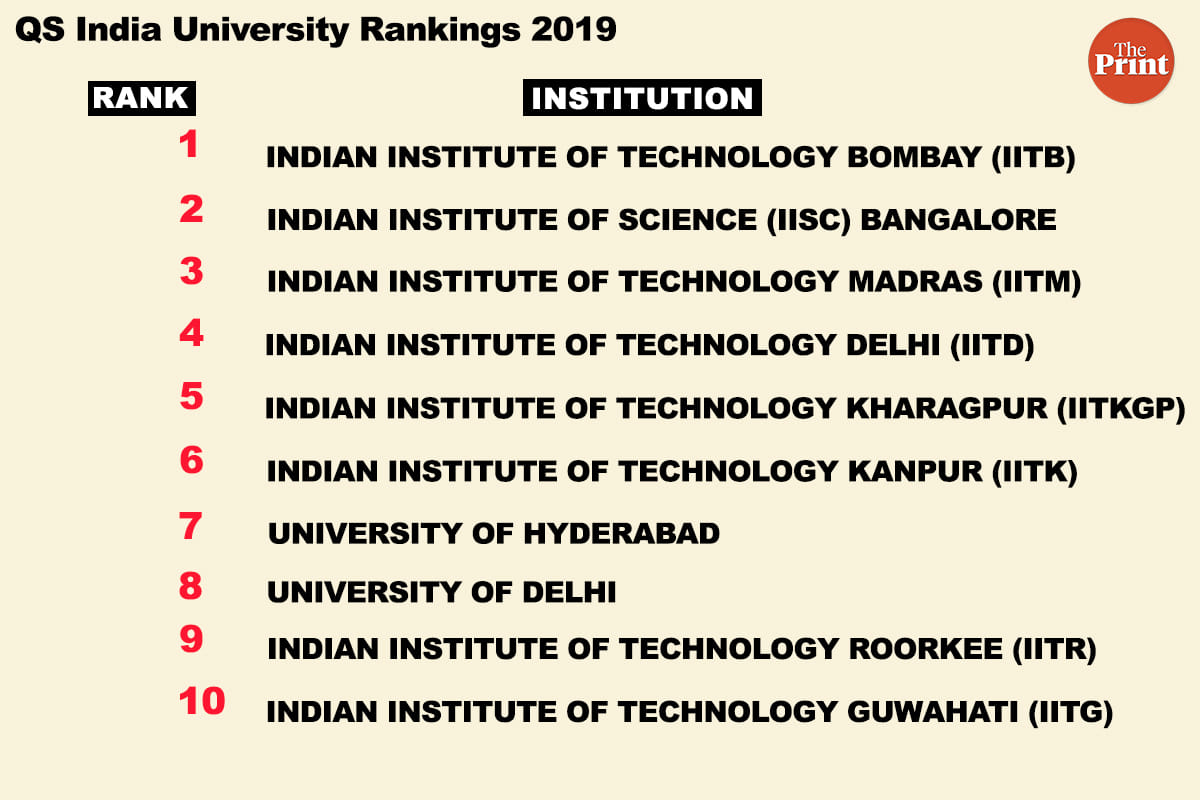QS has launched its first India-specific rankings, in which 7 of the top 10 are IITs. Universities of Hyderabad & Delhi also feature in the 10.
New Delhi: IIT-Bombay is India’s leading higher education institution, followed by the Indian Institute of Science (IISC), Bengaluru, according to the Quacquarelli Symonds (QS) India University Rankings, released on 16 October.
QS is a global higher education company which brings out the QS World University Rankings, the world’s most widely-consulted list of its kind. This is the first edition of the rankings exclusively for Indian institutions.
Also read: For new IITs, govt sets some ground rules — no swimming pool, food court with public money
IITs take up seven of the top 10 places, with the other three being IISc, the University of Hyderabad (7th) and the University of Delhi (8th).
IIT-Bombay, IISc and IIT-Delhi figured in the top 200 in the QS World University Rankings 2019, released in June. The number of Indian universities in the top 1,000 had increased from 20 to 24.

Wide acceptance
Among the 43,000 international employers surveyed, five IITs (Bombay, Madras, Delhi, Kharagpur, Kanpur) and the University of Delhi enjoy outstanding regard.
IIT-Bombay, IIT-Delhi and IISc also earned the most votes from over 83,000 international academics, who were asked to indicate which universities other than their own they rate most highly.
“Twenty Indian institutions receive full marks — 100/100 — in the staff with Ph.D., the indicator designed to identify the extent to which institutions are cultivating a highly-qualified faculty body. In the research productivity indicator, paper per faculty, nine institutions achieve a score between 98.4 and 100,” the report stated.
On a metric-by-metric basis, other institutions also stand out.
The Institute of Chemical Technology, Mumbai, for example, has achieved the highest score on QS’s indicator of ‘research impact’, adjusted for faculty size. It is followed by Shivaji University, Kolhapur. Meanwhile, Tamil Nadu Agricultural University, Coimbatore, achieves the perfect score in the ‘faculty/student’ indicator.
Why a separate Indian ranking
Ben Sowter, research director at QS, explained why the firm had brought out an India-specific ranking.
“QS began its world ranking in 2004, but in response to demand for information on more institutions in more places, drilled deeper in 2009 with the Asian University Rankings,” Sowter said.
“However, beyond the global landscape, the scope of comparison attracting most interest seems to be within a specific location or country. From this year, we have initiated country-specific rankings for India, China, South Korea, Japan and Mexico.”
Asked what Indian institutes need to focus on to improve their global rankings, Sowter said: “Indian universities face a distinctive challenge — that of serving unparalleled domestic demand whilst at the same time keeping an eye on global competitiveness.
“Indian educational institutions have been struggling to keep pace with other countries — particularly some of the more dynamic Asian economies such as China and South Korea — but over the past decade India’s private institutions have been mobilising to become an increasingly important part of the sector and a potentially vital component of India’s future competitiveness.
Also read: There are just 40 foreign teachers at IITs despite govt’s big push for global faculty
“I have no doubt that, as a result of their greater agility, it is only a matter of time before private providers are amongst India’s elite education brands, and amongst the top choices for Indian parents to encourage their children to consider.
“This trend is certain to grow, and policy makers would do well to consider how to empower public institutions to adapt as dynamically.”






